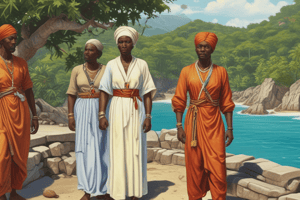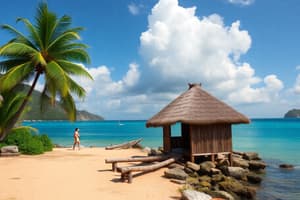Podcast
Questions and Answers
What was the primary purpose of the Virgin Islands' enslaved code of 1783?
What was the primary purpose of the Virgin Islands' enslaved code of 1783?
- To promote active resistance among enslaved persons
- To provide rights to enslaved persons
- To offer rewards for informing on conspirators
- To regulate the movement and behavior of enslaved persons (correct)
What form of resistance involved the deliberate damage of equipment?
What form of resistance involved the deliberate damage of equipment?
- Passive resistance (correct)
- Rebellion
- Marronage
- Active resistance
What was a consequence of being in possession of guns or weapons for enslaved persons?
What was a consequence of being in possession of guns or weapons for enslaved persons?
- Reward
- Freedom
- Punishment (correct)
- Protection
What term refers to the defiance of authority or any force used to control a person?
What term refers to the defiance of authority or any force used to control a person?
What is an example of active resistance?
What is an example of active resistance?
What was a trusted position on a plantation?
What was a trusted position on a plantation?
What is an example of passive resistance?
What is an example of passive resistance?
What was a consequence of informing on conspirators?
What was a consequence of informing on conspirators?
What feature of the Virgin Islands made it difficult for maroon societies to develop?
What feature of the Virgin Islands made it difficult for maroon societies to develop?
What skill did individuals who joined maroon societies need to develop?
What skill did individuals who joined maroon societies need to develop?
What was the primary purpose of having guards patrol at night in Road Town?
What was the primary purpose of having guards patrol at night in Road Town?
What was the consequence of an enslaved person being caught circulating the public streets after 9 p.m. without written permission?
What was the consequence of an enslaved person being caught circulating the public streets after 9 p.m. without written permission?
Why did planters send regular petitions to London?
Why did planters send regular petitions to London?
What was the purpose of the Act of 1787?
What was the purpose of the Act of 1787?
How did enslaved persons use the boats they manned for their masters?
How did enslaved persons use the boats they manned for their masters?
What was a way enslaved persons secretly prepared for maritime marronage?
What was a way enslaved persons secretly prepared for maritime marronage?
Study Notes
Types of Resistance
- Active resistance: deliberate actions, sometimes violent, to bring about or force change
- Passive resistance: non-violent methods to resist or disobey
- Rebellion: defiance of authority or force used to control a person
- Insurrection: rebellion against the government, often involving armed conflict
- Resistance: actions demonstrating refusal to accept or comply with something
Enslavement in the Virgin Islands
- Enslavement was maintained through the use or threat of violence as punishment
- The 1783 enslaved code prohibited unauthorized movement, congregation, and possession of weapons
- Harsh punishments were inflicted for violence against Europeans, while informants were rewarded
- Despite harsh punishment, enslaved persons continued to resist
Forms of Resistance
- Day-to-day resistance (passive resistance): poisoning, damaging equipment, slowing down work, and mutilation
- Rebellions or active resistance: burning down plantations, revolts, and murdering Europeans
- Marronage or running away: individual or group escape from enslavement
Maritime Marronage in the Virgin Islands
- The dominant form of resistance in the Virgin Islands
- Enslaved individuals used their knowledge of surrounding waters to escape to Puerto Rico
- Creoles built canoes or forced sailors to take them to Puerto Rico
- This form of resistance created problems for planters, leading to regular petitions to London
- Planters attempted to limit the problem of runaway persons by patrolling streets at night and mandating European watchmen on fishing boats
Studying That Suits You
Use AI to generate personalized quizzes and flashcards to suit your learning preferences.
Related Documents
Description
Explore the different forms of resistance, including active, passive, rebellion, and insurrection, as well as the history of enslavement in the Virgin Islands.




